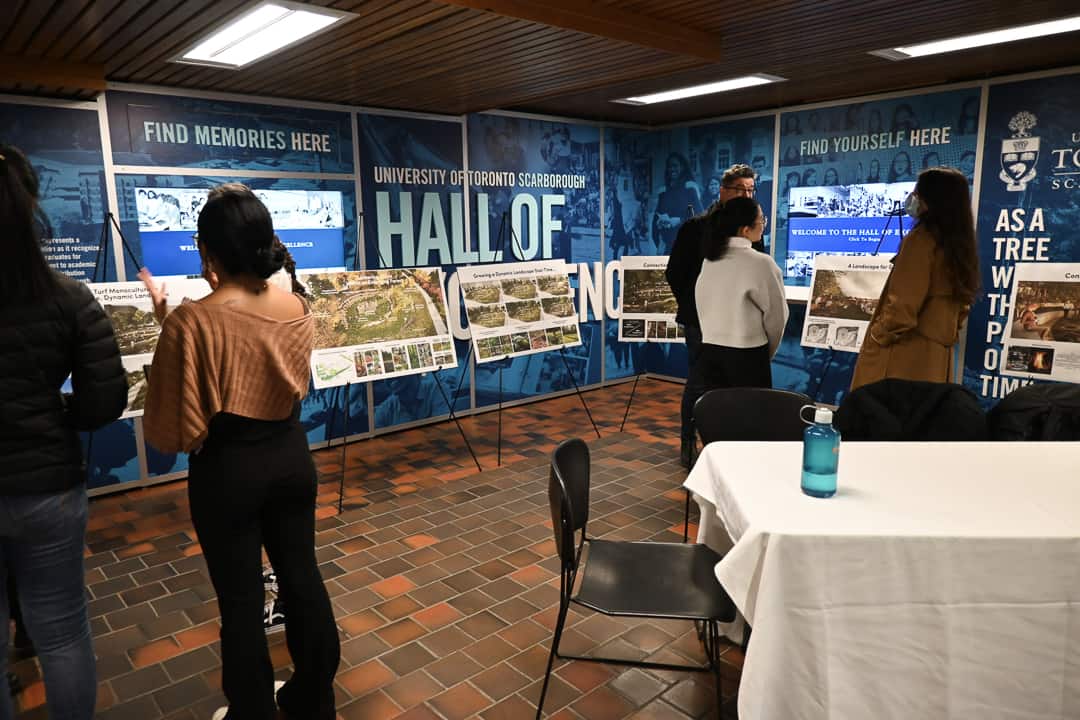On October 18, UTSC community members viewed designs for the upcoming Indigenous Gathering Circle. Staff from UTSC’s Equity, Diversity and Inclusion Office; Design and Construction Management office; and Public Work — a Toronto-based urban design and landscape architecture studio — coordinated the consultation session.
The Gathering Circle will be an attachment to the upcoming Indigenous House at UTSC. “It’s a space to come together and to gather for ceremony,” UTSC’s Assistant Director of Indigenous Initiatives, Kelly Crawford, said in an interview with The Varsity. Both construction projects are slated to be completed by fall 2023.
Staff assembled eight poster boards at the Meeting Place, each of which featured computer-generated perspectives of the Gathering Circle. They also put up a ninth poster board to solicit feedback from community members.
Indigenous Gathering Circle
The Gathering Circle will be located adjacent to the Environmental Science and Chemistry Building and Ellesmere Road. It will feature a series of formal and informal seating; community members can choose to sit on benches, salvaged logs, or the lawn. It will also contain a central fire pit for the ceremony and an emerging forest to enclose the space.
Virginia Fernandez, a project leader and landscape architect with Public Work, said that her team plans to build a Carolinian forest at the Gathering Circle. The Carolinian forest is a hardwood forest that stretches from the Gulf Coast of the United States into southern Ontario and contains over half of Canada’s native tree species. Fernandez said that, compared to other forest models, the Carolinian forest will flourish the most in southern Ontario in the midst of global warming. According to the Government of Canada, Carolinian forests boast levels of biological diversity that are unmatched anywhere else in Ontario.
Her team also plans to expand the vegetation already growing in the Highland Ravine into the Gathering Circle, grow pioneering species — which are species that first inhabit a newly created environment — that reproduce quickly such as aspens and birches and build a flowering meadow.
Fernandez said that Public Work already puts a lot of thought into the sourcing of their plants and materials. “But in this case, I think it’s especially important that we are mindful of where we’re getting the materials,” she said. “We really need input from the Indigenous community to choose the right species for teaching, and we’ll also want to make sure that they’re sustainably harvested.”
Public Work designed the landscaping for the Indigenous House and was hired again to design and manage the construction of the Gathering Circle.
Other planned outdoor spaces for the Indigenous House include an Indigenous garden, a children’s playground, and an outdoor kitchen.
Connections to U of T’s Reconciliation Response Report
The Gathering Circle will serve as the outdoor attachment to Indigenous House, a 10,700 square foot, two-storey building that will serve as a campus hub and a gathering space dedicated to learning about Indigenous cultures and ways of knowing. “[The Gathering Circle] is a specific outdoor space in which different teachings and sharing of knowledge can happen,” said Crawford.
The construction of the Gathering Circle and Indigenous House reflects U of T’s Reconciliation Response Report, Answering the Call: Wecheehetowin. U of T commissioned the report in 2016 to assess how the university could implement the calls to action put forward by the Truth and Reconciliation Commission of Canada (TRC) in 2015. The TRC report included 94 Calls to Action that aim to address the legacy of residential schools in Canada and “advance the process of reconciliation.”
One of the 34 calls to action in Answering the Call: Wecheehetowin is to create “dedicated, appropriate Indigenous spaces on the UTM and UTSC campuses.” Each of the working groups that were consulted in the report stressed that current spaces at U of T dedicated to Indigenous Peoples “were lacking in both number and features,” which could hinder the recruitment, retention, and flourishing of Indigenous community members at U of T.
In September, UTSC Vice-Principal, Academic and Dean William Gough reported that UTSC currently employs 10 self-identifying Indigenous faculty members. However, it is not known how many Indigenous students attend the campus.
Answering the Call: Wecheehetowin also noted that indigenizing existing spaces and building dedicated Indigenous spaces on campus would “aid in the education of the U of T community as a whole about Indigenous people.”
Community feedback
Feedback from community members at the event was generally positive. Community members wrote on post-it notes that they were “happy” and “excited” to see the Gathering Circle come to fruition, and praised the design of the Gathering Circle as “stunning” and “a great use of the space.”
One community member wrote, “I like the use of land to (re)-introduce indigenous flora to the area, as monocultures are not conducive to our campus conservation [of] land.” Another suggested that all signs at the Gathering Circle be written in Indigenous languages.
“We would like to get [feedback] from everyone — students, faculty, and staff — on what they think… because this is a very important project to the campus,” said Mayes Rihani, a senior manager with UTSC’s Design and Construction Management office, in an interview with The Varsity.
“Hopefully, [the Gathering Circle] can help build relationships between everyone here at UTSC,” said Crawford.


